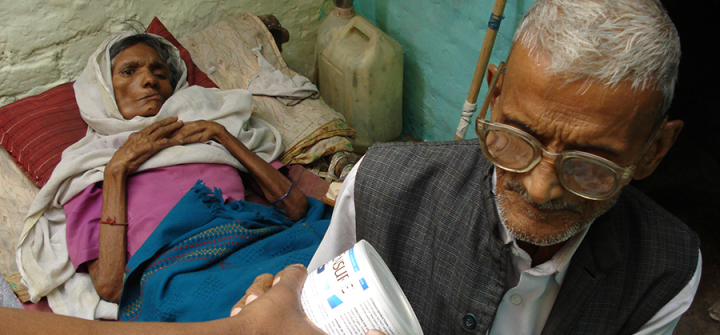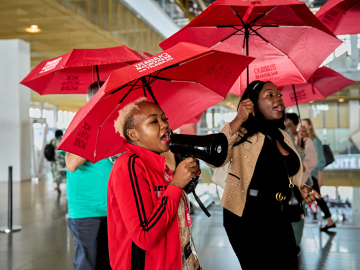Palliative Pain Relief Woefully Inadequate Worldwide
In 2014, a couple named Thampan and Padmini sat in a hospital room in the Kasaragod district of India watching their 9-year-old son as he suffered from agonizing pain in the end-stages of a terminal disease. His 2 siblings had already died, reportedly from the effects of exposure to a pesticide used on cashew plantations. Unable to obtain any pain medication to provide their son relief, the parents grew desperate. They wrote a note, hanged the boy from his hospital room window, and then hanged themselves from the ceiling fan, according to a report in The Times of India.
Such a horrific scene seems unimaginable, but in much of the world, unrelieved suffering is a daily reality. “I don’t have to imagine it; I see it in front of me all the time,” says M. R. Rajagopal, MD, a palliative care doctor at Trivandrum Institute of Palliative Sciences in Kerala, India. “In most of the world, pain is not treated effectively. People just bear the pain and live through the agony, suffering. Post-operative pain is simply not addressed—except in some expensive hospitals—but not for the common man,” Rajagopal says.
The day before we spoke, Rajagopal had been to visit an elderly couple—a very sick man and his caregiver wife. Although Rajagopal had been seeing the man for palliative care for a month, the pain relief the doctor offered was not enough. “That’s common,” Rajagopal says. “Only about three quarters of pain can be easily treated with analgesics.” The man was in pain, delirious, incontinent, and elderly, with a single caregiver. “We wanted to take him inpatient to control his pain before sending him back home, but we cannot do it [for a few more days]. The look on not only the patient’s face but the caregiver’s….it was not easy to see that and come away without doing anything effective. So this kind of suffering is there all over the developing world.”
The glaring inequity in access to palliative care was researched, quantified and published in an October 2017 Lancet Commission report co-chaired by Felicia Knaul, PhD, a health economist at the University of Miami, and by influential medical anthropologist Paul Farmer, MD, now at Harvard Medical School. The report shows that of the roughly 56 million people who died worldwide in 2015, nearly half of them—25.5 million people—died with what the authors called serious health-related suffering, including unrelieved pain. For another 35.5 million people who survived their illnesses, palliative care was unavailable. The vast majority of those people—80%—lived in developing regions without access to care. An estimated 2.5 million children died suffering. Whereas in high-income countries children only make up 1% of people who died with severe health-related suffering, in low-income countries, a third are children, the report found.
“The Commission has uncovered an appalling oversight in global health,” Richard Horton, FRCP, editor of the Lancet, wrote in a comment published alongside the report. “It is time for that oversight to be remedied.”
Pain relief is a cornerstone of palliative care, a term that describes the care of symptoms without a curative aim. Palliative care is often associated with end-of-life care, but it may be required with any serious disease or injury. In addition to addressing physical symptoms and pain relief, palliative care aims to provide dignity and quality of life—however short it may be—through psychosocial and spiritual support for the patient and their family by nurses, clergy and other professionals. (Hospice care provides similar support, but usually is provided to people with a prognosis of six months or less.)
The idea that people with serious diseases should die—or continue to live—free from pain and with personal dignity is a relatively new concept even in the West. Though it has earlier roots in the 19th century, modern palliative care was pioneered in the 1950s by Dame Cicely Saunders, a young British nurse who saw a need for more dignified care and pain relief in particular. Saunders became a doctor and in 1967 opened St. Christopher’s Hospice, the birthplace of modern palliative care.
The WHO helped advance palliative care in 1986 with the publication of their “Pain Relief Ladder” to help address untreated cancer pain. In 1990, WHO officially defined palliative care, and a 2002 revision extended the definition beyond cancer patients. But although awareness and availability of palliative care has spread tremendously in the past 50 years, there remains an “access abyss” to care between those in high-income countries and low- and middle-income countries, as the Lancet Commission report detailed. The divide is made worse by the lack of access to inexpensive pain-relieving morphine in much of the world, while the US consumes more than 85 percent of the world’s opioids. (Look for more on the global inequality in opioid availability when Part 2 is published on April 18, 2018).
“I came to realization that this suffering is the truth in the world, it’s a hidden abysmal inequity” in access even to basic pain relief at the end of life, says Knaul of her work with the Commission. “People had written about it before, but very few people had paid attention.”
Knaul has a blunt reason for why the crisis had attracted such little focus from policymakers and others: “We have never valued the suffering of the poor the way we value that of the rich. It has never been a priority.”
The enormous stigma that surrounds death and dying is an underlying reason. “We shy away from the topic because we are uncomfortable. This is all about the value of human life, of suffering. We need to address these questions, and they are complicated ethical debates,” she says.
Rajagopal, also a member of the Lancet Commission, says that stigma has manifested in health care as a focus on diseases, rather than suffering. “It is convenient for health care systems, for hospitals, doctors, government officials, to look at diseases, because looking at suffering is harder. Diseases are easily diagnosed and measured. Suffering is not so easily measured or addressed. It extends to psychosocial issues, not just medical symptoms,” he says. The Commission report was a first step to bringing more awareness of severe health-related suffering to the attention of governments and NGOs so that it can be addressed in efforts to provide universal health coverage.
Cicely Saunders, the palliative care pioneer, reportedly once said to a traveling companion on an expedition, “If one man from a poor village in India dies without pain because of what I have done, it will all have been worthwhile.” That goal certainly has been met, but for millions of poor villagers throughout the world, palliative care and pain relief are still the exception rather than the norm.
The second part of this 3-part series will examine the inequities in access to inexpensive opioid painkillers, and how the barriers of cost and fear might be addressed. The third part will provide ideas about a path to providing the critical services to alleviate suffering and restore dignity to those with serious illness.
This is part I of a GHN exclusive 3-part series, A World in Agony: The Global Need for Pain Treatment. Read Part II, Opiophobia and High Costs: Untangling the Barriers to Palliative Care, here, and Part III, A Fighting Chance for Palliative Care, here.
Join the tens of thousands of subscribers who rely on Global Health NOW summaries and exclusive articles for the latest public health news. Sign up for our free weekday enewsletter, and please share the link with friends and colleagues: http://www.globalhealthnow.org/subscribe.html
A home care nurse (not seen) in New Delhi, India, offers a tin of nutritional supplement to the husband of a patient with cancer of the salivary gland in the terminal stages. © 2007 Divya Pal Singh, Courtesy of Photoshare




